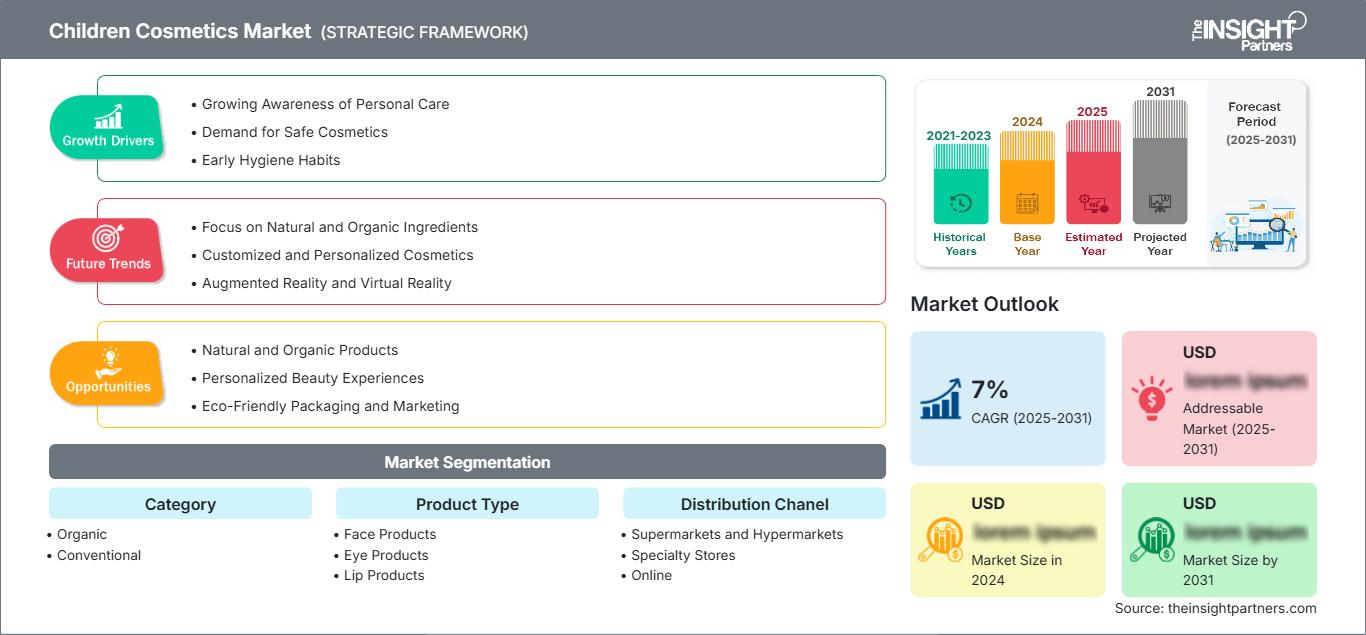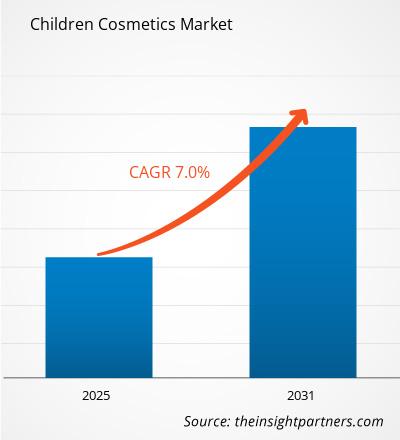Se espera que el mercado de cosméticos para niños registre una CAGR del 7% entre 2025 y 2031, con un tamaño de mercado que se expandirá de US$ XX millones en 2024 a US$ XX millones en 2031.
El informe de mercado de Cosméticos Infantiles está segmentado por categoría en Productos Orgánicos y Productos Convencionales. El segmento de tipo de producto incluye Productos Faciales, Productos para Ojos y Productos Labiales. El segmento de usuario final incluye Consumidores y Minoristas. La evaluación de mercado se presenta en dólares estadounidenses para el análisis segmentario mencionado. El análisis global se desglosa a nivel regional y por países principales. La evaluación de mercado se presenta en dólares estadounidenses para el análisis segmentario mencionado.
Propósito del Informe
El informe "Mercado de Cosméticos Infantiles" de The Insight Partners busca describir el panorama actual y el crecimiento futuro, los principales factores impulsores, los desafíos y las oportunidades. Esto proporcionará información a diversos actores del sector, como:
- Proveedores/fabricantes de tecnología: Para comprender la dinámica cambiante del mercado y conocer las oportunidades potenciales de crecimiento, lo que les permitirá tomar decisiones estratégicas informadas.
- Inversores: Realizar un análisis exhaustivo de tendencias respecto a la tasa de crecimiento del mercado, las proyecciones financieras del mercado y las oportunidades que existen en toda la cadena de valor.
- Órganos reguladores: Regular las políticas y las actividades policiales en el mercado con el objetivo de minimizar el abuso, preservar la confianza de los inversores y defender la integridad y estabilidad del mercado.
Segmentación del mercado de cosmética infantil.
Categoría
- Orgánico
- Convencional
Tipo de producto
- Productos faciales
- Productos para los ojos
- Productos para labios
Canal de distribución
- Supermercados e hipermercados
- Tiendas especializadas
- En línea
Geografía
- América del Norte
- Europa
- Asia-Pacífico
- América del Sur y Central
- Oriente Medio y África
Obtendrá personalización en cualquier informe, sin cargo, incluidas partes de este informe o análisis a nivel de país, paquete de datos de Excel, así como también grandes ofertas y descuentos para empresas emergentes y universidades.
Mercado de cosmética infantil: Perspectivas estratégicas

-
Obtenga las principales tendencias clave del mercado de este informe.Esta muestra GRATUITA incluye análisis de datos, desde tendencias del mercado hasta estimaciones y pronósticos.
Factores que impulsan el crecimiento del mercado de cosmética infantil
- Creciente conciencia sobre el cuidado personal: la mayor conciencia entre los niños y los padres sobre la importancia del cuidado personal está impulsando el crecimiento del mercado de cosméticos infantiles.
- Demanda de cosméticos seguros: los padres buscan productos cosméticos seguros que sean apropiados para la edad y la salud de los niños, lo que contribuye a la demanda de opciones de alta calidad.
- Hábitos de higiene tempranos: Los padres reconocen la importancia de inculcar hábitos de higiene adecuados en los niños desde una edad temprana, lo que influye en las decisiones de compra de cosméticos.
- Cultura de influencers y tendencias de belleza: las redes sociales y los influencers han hecho que las tendencias de belleza sean más accesibles para el público más joven, lo que impacta en las preferencias cosméticas de los niños.
Tendencias futuras del mercado de cosméticos infantiles
- Enfoque en ingredientes naturales y orgánicos: la creciente demanda de cosméticos no tóxicos y seguros está impulsando el énfasis en el uso de ingredientes naturales y orgánicos en los cosméticos para niños.
- Cosméticos personalizados y a medida: Las innovaciones en productos cosméticos personalizados y a medida permiten a los niños expresar su individualidad y creatividad.
- Realidad aumentada y realidad virtual: los avances tecnológicos como AR y VR están transformando la forma en que los niños interactúan con los productos cosméticos, permitiéndoles probar virtualmente diferentes looks y productos.
- Posicionamiento de marca para el éxito futuro: Las marcas que se centran en la sostenibilidad, la seguridad y las experiencias personalizadas estarán mejor posicionadas para el éxito a largo plazo en el mercado de cosméticos infantiles.
Oportunidades de mercado en cosméticos infantiles
- Productos naturales y orgánicos: El mercado de cosméticos naturales y orgánicos para niños se está expandiendo a medida que los padres priorizan productos libres de aditivos químicos o sintéticos.
- Experiencias de belleza personalizadas: las marcas pueden capitalizar el creciente interés en productos de belleza personalizados que se adaptan a preferencias y tipos de piel específicos, ofreciendo soluciones únicas y personalizadas.
- Embalaje y marketing ecológicos: Las marcas que se centran en embalajes ecológicos y estrategias de marketing innovadoras probablemente atraerán tanto a los consumidores jóvenes como a sus padres, lo que impulsará el crecimiento del mercado.
- Oportunidades para la innovación de marca: al ofrecer líneas de productos creativas y centrarse en la sostenibilidad, las marcas pueden ganar una atención significativa y ampliar su participación de mercado en el sector de los cosméticos infantiles.
Perspectivas regionales del mercado de cosméticos infantiles
Los analistas de The Insight Partners han explicado detalladamente las tendencias regionales y los factores que influyen en el mercado de cosméticos infantiles durante el período de pronóstico. Esta sección también analiza los segmentos y la geografía del mercado de cosméticos infantiles en América del Norte, Europa, Asia Pacífico, Oriente Medio y África, y América del Sur y Central.
Alcance del informe de mercado de cosméticos infantiles
| Atributo del informe | Detalles |
|---|---|
| Tamaño del mercado en 2024 | US$ XX millones |
| Tamaño del mercado en 2031 | US$ XX millones |
| CAGR global (2025-2031) | 7% |
| Datos históricos | 2021-2023 |
| Período de pronóstico | 2025-2031 |
| Segmentos cubiertos |
Por categoría
|
| Regiones y países cubiertos |
América del norte
|
| Líderes del mercado y perfiles de empresas clave |
|
Densidad de actores del mercado de cosmética infantil: comprensión de su impacto en la dinámica empresarial
El mercado de cosméticos infantiles está creciendo rápidamente, impulsado por la creciente demanda del usuario final debido a factores como la evolución de las preferencias de los consumidores, los avances tecnológicos y un mayor conocimiento de los beneficios del producto. A medida que aumenta la demanda, las empresas amplían su oferta, innovan para satisfacer las necesidades de los consumidores y aprovechan las tendencias emergentes, lo que impulsa aún más el crecimiento del mercado.

- Obtenga una descripción general de los principales actores clave del mercado de cosmética infantil.
Puntos clave de venta
- Cobertura integral: el informe cubre exhaustivamente el análisis de productos, servicios, tipos y usuarios finales del mercado de cosméticos para niños, proporcionando un panorama holístico.
- Análisis de expertos: el informe se compila con base en el conocimiento profundo de expertos y analistas de la industria.
- Información actualizada: El informe asegura relevancia comercial debido a su cobertura de información reciente y tendencias de datos.
- Opciones de personalización: este informe se puede personalizar para satisfacer los requisitos específicos del cliente y adaptarse adecuadamente a las estrategias comerciales.
Por lo tanto, el informe de investigación sobre el mercado de cosméticos infantiles puede ayudar a descifrar y comprender el panorama de la industria y sus perspectivas de crecimiento. Si bien existen algunas preocupaciones válidas, las ventajas generales de este informe suelen superar las desventajas.
- Análisis histórico (2 años), año base, pronóstico (7 años) con CAGR
- Análisis PEST y FODA
- Tamaño del mercado, valor/volumen: global, regional y nacional
- Industria y panorama competitivo
- Conjunto de datos de Excel
Informes recientes
Informes relacionados
Testimonios
Razón para comprar
- Toma de decisiones informada
- Comprensión de la dinámica del mercado
- Análisis competitivo
- Información sobre clientes
- Pronósticos del mercado
- Mitigación de riesgos
- Planificación estratégica
- Justificación de la inversión
- Identificación de mercados emergentes
- Mejora de las estrategias de marketing
- Impulso de la eficiencia operativa
- Alineación con las tendencias regulatorias






















 Obtenga una muestra gratuita para - Mercado de cosméticos para niños
Obtenga una muestra gratuita para - Mercado de cosméticos para niños